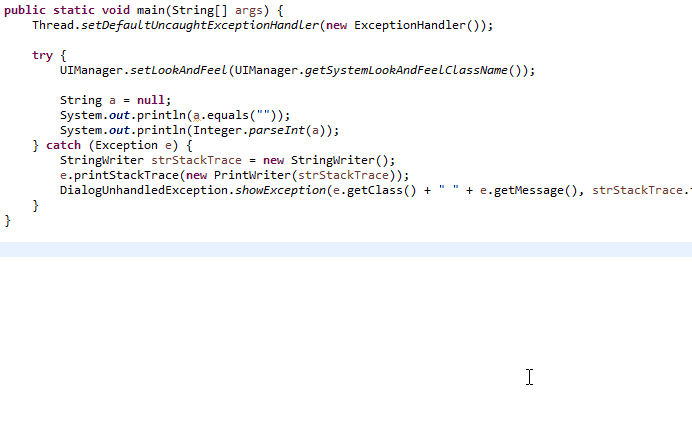This screen can be built entirely by hand, if you make sure to have it in your application, follow an example I developed, the code is with the proper observations:
import java.awt.BorderLayout;
import java.awt.Dimension;
import java.awt.event.ItemEvent;
import java.awt.event.ItemListener;
import javax.swing.BorderFactory;
import javax.swing.Box;
import javax.swing.BoxLayout;
import javax.swing.JButton;
import javax.swing.JFrame;
import javax.swing.JPanel;
import javax.swing.JScrollPane;
import javax.swing.JTextPane;
import javax.swing.JToggleButton;
/**
*
* @author diego.felipe
*/
public class DialogUnhandledException {
// algumas IDE's podem reclamar de codificação de texto,
// por causa destes simbolos, por isso deve-se manter
// a codificação UTF-8 ou alterar os simbolos
private static final String BUTTON_ARROW_NORTH = "▲";
private static final String BUTTON_ARROW_SOUTH = "▼";
private static final String MESSAGE_DEFAULT = "An unhandled exception has occurred in your application. "
+ "Click on Details for more information or click Quit to close the application immediately.";
private DialogUnhandledException() {
}
public static void showException(String shortError, String strStackTrace) {
// - fixedWith é um tamanho fixo para o frame não ficar redimensionando
// ao abrir o JTextPane contendo a stacktrace.
// - minHeight é o tamanho minimo do frame, quando o JTextPane da
// StackTrace não estiver visível.
// - maxHeight é a altura máxima do frame, comportando o JTextPane da
// stracktrace aberto.
int fixedWidth = 450;
int minHeight = 135;
int maxHeight = 300;
JFrame frame = new JFrame();
frame.getContentPane().setLayout(new BorderLayout());
// obrigatório, para que o BorderLayout não redimensione automaticamente
frame.setPreferredSize(new Dimension(fixedWidth, minHeight));
frame.setDefaultCloseOperation(JFrame.EXIT_ON_CLOSE);
// painel principal que comportará os paineis de botoes
// e da mensagem padrao
JPanel principalPane = new JPanel();
principalPane.setLayout(new BoxLayout(principalPane, BoxLayout.Y_AXIS));
// painel onde será comportado o JTextPane com a mensagem
// padrão mais a mensagem de erro sem o stacktrace
JPanel messageDefaultPane = new JPanel(new BorderLayout(0, 5));
messageDefaultPane.setBorder(BorderFactory.createEmptyBorder(3, 3, 0, 0));
// componente onde será exibida a mensagem de erro padrao
JTextPane tp_messageDefault = new JTextPane();
tp_messageDefault.setBackground(frame.getBackground());
tp_messageDefault.setEditable(false);
tp_messageDefault.setText(MESSAGE_DEFAULT + "\n\n" + shortError);
messageDefaultPane.add(tp_messageDefault, BorderLayout.CENTER);
// scrollPane comportará o JTextPane que exibirá o stacktrace quando o
// botao for clicado
JScrollPane scrollPane = new JScrollPane();
JTextPane tp_stackTrace = new JTextPane();
tp_stackTrace.setBackground(frame.getBackground());
tp_stackTrace.setEditable(false);
// painel contendo os botoes Detais, Quit e Continue
JPanel buttonPane = new JPanel();
buttonPane.setLayout(new BoxLayout(buttonPane, BoxLayout.LINE_AXIS));
buttonPane.setBorder(BorderFactory.createEmptyBorder(5, 0, 5, 10));
// Como o estado do botão Details servirá para exibir ou ocultar
// o JToggleButton faz mais sentido aqui
JToggleButton btn_showDetails = new JToggleButton("Details " + BUTTON_ARROW_SOUTH);
btn_showDetails.addItemListener(new ItemListener() {
@Override
public void itemStateChanged(ItemEvent e) {
// quando o status do botao for "selecionado", a stacktrace será
// atribuida no JTextPane, o frame terá sua altura alterada
// para maxHeight e a posição da barra de scroll
// ficará no topo do erro
if (e.getStateChange() == ItemEvent.SELECTED) {
tp_stackTrace.setText(strStackTrace);
frame.setPreferredSize(new Dimension(fixedWidth, maxHeight));
tp_stackTrace.setCaretPosition(0);
frame.pack();
btn_showDetails.setText("Detalhes " + BUTTON_ARROW_NORTH);
// quando o status anterior do botao for desfeito, remove a
// stacktrace do componente de texto e redefine
// a altura minima para o frame
} else if (e.getStateChange() == ItemEvent.DESELECTED) {
tp_stackTrace.setText(null);
frame.setPreferredSize(new Dimension(fixedWidth, minHeight));
frame.pack();
btn_showDetails.setText("Detalhes " + BUTTON_ARROW_SOUTH);
}
}
});
// funcionalidades não implementadas
JButton btn_continue = new JButton("Continue");
JButton btn_quit = new JButton("Quit");
buttonPane.add(btn_showDetails);
buttonPane.add(Box.createHorizontalGlue());
buttonPane.add(btn_continue);
buttonPane.add(Box.createRigidArea(new Dimension(10, 0)));
buttonPane.add(btn_quit);
scrollPane.setViewportView(tp_stackTrace);
principalPane.add(messageDefaultPane);
principalPane.add(buttonPane);
frame.add(principalPane, BorderLayout.NORTH);
frame.add(scrollPane, BorderLayout.CENTER);
frame.pack();
frame.setLocationRelativeTo(null);
frame.setVisible(true);
}
}
Its use is very simple, and following the @Maniero response, it can be used in conjunction with the class suggested in his reply, but for this, it is necessary to convert the error messages and the stackTrace for string:
import java.io.PrintWriter;
import java.io.StringWriter;
public final class ExceptionHandler implements Thread.UncaughtExceptionHandler {
@Override
public void uncaughtException(Thread thread, Throwable throwable) {
StringWriter strStackTrace = new StringWriter();
throwable.printStackTrace(new PrintWriter(strStackTrace));
DialogUnhandledException.showException(throwable.toString(), strStackTrace.toString());
}
}
To work, simply set the class as the default handler of exceptions not captured. The line below should be the first of the application:
public class Programa{
public static void main(String[] args) {
// registra nossa classe como manipulador padrao de
// exceções não capturadas
Thread.setDefaultUncaughtExceptionHandler(new ExceptionHandler());
String a = null;
System.out.println(a.equals(""));
System.out.println(Integer.parseInt(a));
}
}
A less drastic solution (also suggested by @Maniero in the other answer), is to put on main, surrounding the stretch that starts its application by a block try-catch:
public class Programa{
public static void main(String[] args) {
try {
// define o look And Feel de acordo com o tema do SO em execução
UIManager.setLookAndFeel(UIManager.getSystemLookAndFeelClassName());
String a = null;
System.out.println(a.equals(""));
System.out.println(Integer.parseInt(a));
} catch (Exception e) {
StringWriter strStackTrace = new StringWriter();
e.printStackTrace(new PrintWriter(strStackTrace));
SwingUtilities.invokeLater(() -> DialogUnhandledException.
showException(e.getClass() + " " + e.getMessage(),strStackTrace.toString()));
}
}
}
The result for both forms would be similar to the image below:

Remembering that to look like this, it is necessary that it is running on Windows, if the Swing application runs on Linux or OSX, the appearance will be according to the running operating system theme.


You in case you want to mount a screen equal to the behavior of this...?
– Rafael Withoeft
exact. A priori the screen will be smaller without showing these details, and then yes, when I click on Jbutton 'Details', it expands me and show me the details inside a Jtexarea and such... ?
– Samuel Gabriel
I don’t have time to test the idea at the moment, so I won’t post an answer. But if you just hide/display the
JTextAreaat the click of the button, it should just be a matter of calling the methodpackwindow.– Luiz Vieira
Take a look at [tour]. You can accept an answer if it solved your problem. You can vote on every post on the site as well. Did any help you more? You need something to be improved?
– Maniero